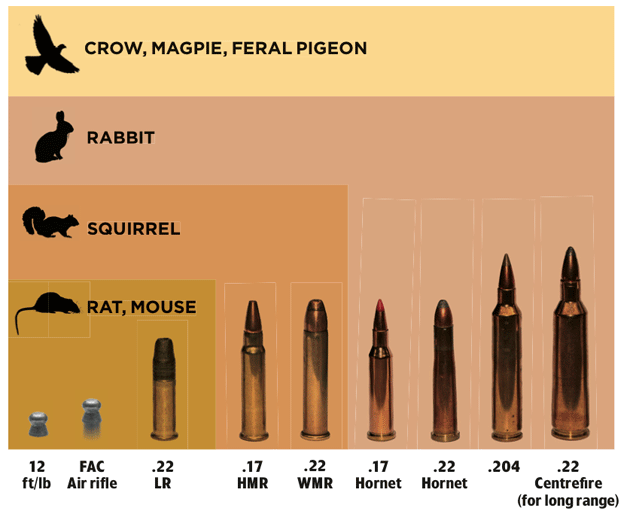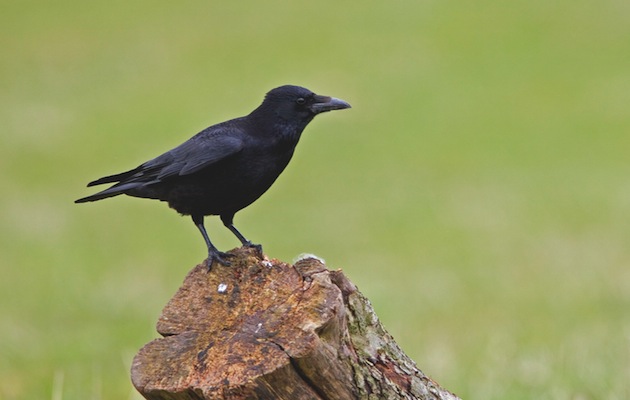Pest control is rather a blanket term because there are obviously a variety of pest control needs - for rats, foxes, crows... Here Bruce Potts helps you to make a suitable choice.

What I’m going to do here is highlight the various cartridges available and their usefulness in pest control. It’s impossible to choose a calibre for all the different species of pests – a rabbit and a poult-pinching fox cannot be compared. While many cartridges come close to covering all bases, no single round will be suitable for all pests in all circumstances.
Small pest control
I shoot as much small game with an air rifle, both sub-12ft/lb and on a Firearms Certificate (FAC), as I do with a rimfire. So for small pest control work I could recommend an air rifle. However, cartridge-wise, I’d say the humble .22 rimfire is your choice.
That said, all .22 rimfires are not the same and you have a major choice of loads from which to choose. Personally I use a huge variety of .22 rimfire cartridges, from the tiny squib bulleted breach (BB) caps to the relatively hefty .22 Winchester Magnum Rimfire (WMR) loads. Each has its own particular talents and uses.
Due to their dimunitive size BB and conical ball (CB) caps are single-shot only. However they are very useful for the nuisances of mice, rats or ferals in confined spaces. Their maximum effective range is 10 yards. Beyond that they are not accurate enough, but they shoot 15.5-gr and 16-gr bullets at 880fps and 950fps for 27ft/lb and 33ft/lb energy respectively.
Better are the little .22 Shorts. These can be reduced velocity at 710fps as with the CCI CB load, or you can have a standard load that shoots a 27-gr bullet at 1,105fps. In a pump-action Winchester they are excellent for dealing with squirrels.
Possibly my first choice are the CB Long loads that feed through a standard magazine bolt-action rifle and send a 29-gr bullet at 705fps for 32ft/lb — basically a rimfire version of an FAC air rifle in some respects. The effective range is 20 yards at best but it’s quiet with a sound moderator fitted.
Cartridges for shooting rabbits
First choice for all-round use on rabbits are the .22 LR subsonic loads. Here hollowpoint bullets ensure maximum expansion of the bullet and delivery of the bullet’s energy into the vital area for a humane shot. You should still be aiming for head shots though. The .22LR high velocity (HV) has its place if you really have to use a .22LR for foxes, but keep these ranges short and take head shots only. Velocities of 1,245fps to 1,650fps can be achieved, but with lighter bullets that lose velocity quickly.
You’ll find 40-gr subsonic bullets from any of the manufacturers such as RWS, Eley, Winchester or CCI that will deliver approximately 95ft/lb. It is the rifle that chooses the bullets it likes, not you. No one manufacturer is a better choice than another.
If you have a semi-automatic .22 rimfire then dependability is important and the new RWS Semi Auto cartridge is superb. Yes it is a solid bullet, not hollowpoint, but as head shots are the norm, it is of no consequence.
![pest cartridge]() Cartridges for shooting foxes
Cartridges for shooting foxes
At short ranges and with higher velocity ammo a .22LR can be deadly against a fox, as long as you place head shots accurately. The problem is that as the range passes 50 yards, the odds of a humane shot are stacked against you. I have called in and baited foxes in barn areas and used .22 rimfires to good effect, but the .17 HMR is best if you don’t want a centrefire.
Here again the 17-gr V-Max bullet for the HMR is the most common and is certainly capable of despatching a fox humanely, but at sensible ranges and with good shot placement. I prefer the CCI 20-gr GamePoint load, as it’s accurate, and the extra weight and slower expansion helps penetrate the fox’s exterior before delivering its energy, whereas a more fragile .17 HMR 17-gr bullet might fragment on a bone on its way in.
Alternatively, the older .22 WMR — the inspiration behind the .17 HMR — is still a good fox cartridge. The new Hornady 30-gr V-Max load is effective at closer ranges with a velocity of 2,200fps and striking energy of 322ft/lb.
Better still is the new .17 Hornet round. This new round is actually similar to the old .17 AK Hornet but it lets you use a lightweight rifle with the availability to reload your ammunition to suit your need and game species. Here a 20-gr bullet can be pushed at 3,650fps for 592ft/lb energy, a good flat-shooting bullet for rabbits, crows and foxes.
This brings you nicely to the .22 Hornet — old but still a cracking little round. The advantage here is you can up the bullet weights over the .17 and there are a lot of ammunition or reload choices. RWS makes a good factory loading, while I have always liked a reload recipe of 35-gr V-Max bullet with 11 grains of Vit N110 for 3,050fps.
![hare fox cartridge]()
The big guns
Realistically, a centrefire is usually the most suitable for anything larger than a hare. The newer .204 Ruger is a capable round delivering a blend of higher ballistic coefficient bullets for better down-range performance and accurate shot placement. Either a 32-gr or 40-gr factory load is effective, with velocities of 4,225fps and 3,900fps respectively. The 32-gr bullet zeroed at 100 yards is still within the kill zone of a fox at 275 yards.
Next up are the old retainers, .222 Rem, .223 Rem, .22-250 and the .220 Swift rounds. The .222 Rem is a wonderful round — sweet to shoot, low recoil, accurate and available in a wide variety of lighter weight or heavy varmint rifle configurations. With a sound moderator fitted you have yourself a quiet effective fox round to 250 yards or so and it doubles up as a small species deer round, with the correct bullets.
I like the Norma 40-gr V-Max factory load at 3,051fps and 1,137ft/lb is an accurate round with reloads such as the 55-gr Sierra soft nose bullet on top of 25-gr of Varget powder for 3,095fps and 1,170 ft/lb. If you want a tad more range or want to use a heavier bullet then the .223 Rem is an excellent choice. Slightly bigger than the .222, the .223 is great for small game or foxes. You can load with bullets as light as 30-gr up to 90-gr if necessary. But you will need a rifle with fast-twist rifling, 1-in- 9in or 1-in-7in to stabilise bullets above 70-gr as the standard 1-in-12in is only good for the lighter bullets. Regardless, the .223 Rem does everything the .222 Rem does but just that little bit better. A good load is 40-gr V-Max and 25-gr of RL10X for 3,750fps for smaller game giving accurate longer-range shots if necessary and safer more frangible bullets, while a load of 23.5 grains of Vit N133 and a 50-gr Berger Varmint gives 3,400fps plus and is ideal for foxes. I’ve been using .223 GECO 56- gr Express factory ammo with excellent results on small game and on foxes.
Then there’s a big change in size to the .22-250 round, which is the old .250 Savage round necked down to .224 calibre. You can use the .22-250 two ways: a superb flat-shooting long- range small vermin round with a 40-gr bullet travelling at 4,100fps delivering 1,493ft/lb — excellent for watchful crows at long range. Then load a heavier bullet such as the 55-gr V-Max and you have a good short or longer-range fox load.
The extra speed of the .22-250 over the smaller .222 or .223 rounds means a flatter trajectory so less sight adjustment and less wind drift — more chance of a good hit. The downside is more noise and a little more recoil, both of which you can reduce by fitting a good sound moderator. Also if you reload a .22-250 you can reduce the load to a .223 level for shorter or smaller game if necessary, but you can never load a .223 to the velocity of a .22-250.
Similarly the big .220 Swift is an old one but still a good one, delivering a 50-gr bullet at 3,950fps for 1,732ft/lb. Whilst I like it, I have to say that a .22- 250 is more practical as more rifles are chambered in it.
Most importantly
I like the odd calibres, but the reality is that a good .22LR will sort you for all your small game issues, a .17 HMR bridges the gap between small game and foxes (with the right ammo and at shorter ranges) while a good centrefire is really the best for foxes. Plus a .22 centrefire can double as a small species deer rifle with the right ammunition.
I have missed out the .17 Rem, .17 Fireball and many .20 cal wildcats. However the ones I have detailed here are in the most common use.
What you need to remember, however appropriate your ammunition, is to ensure that your ranges are realistic, your rifle suits your shooting and your shot placement is accurate.



